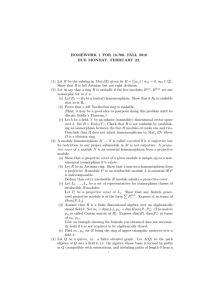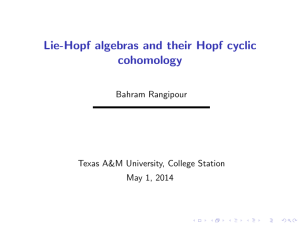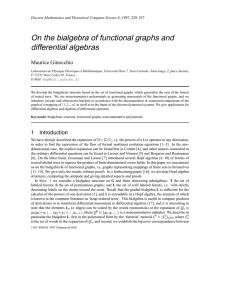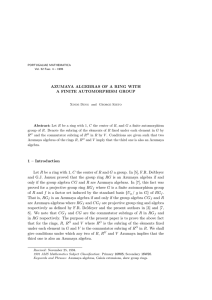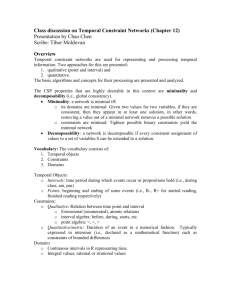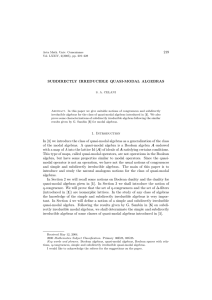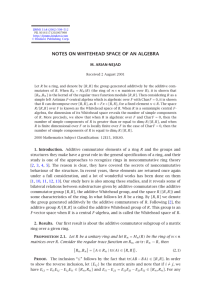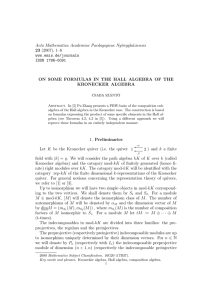Center of Twisted Graded Hecke Algebras Groups ?
advertisement
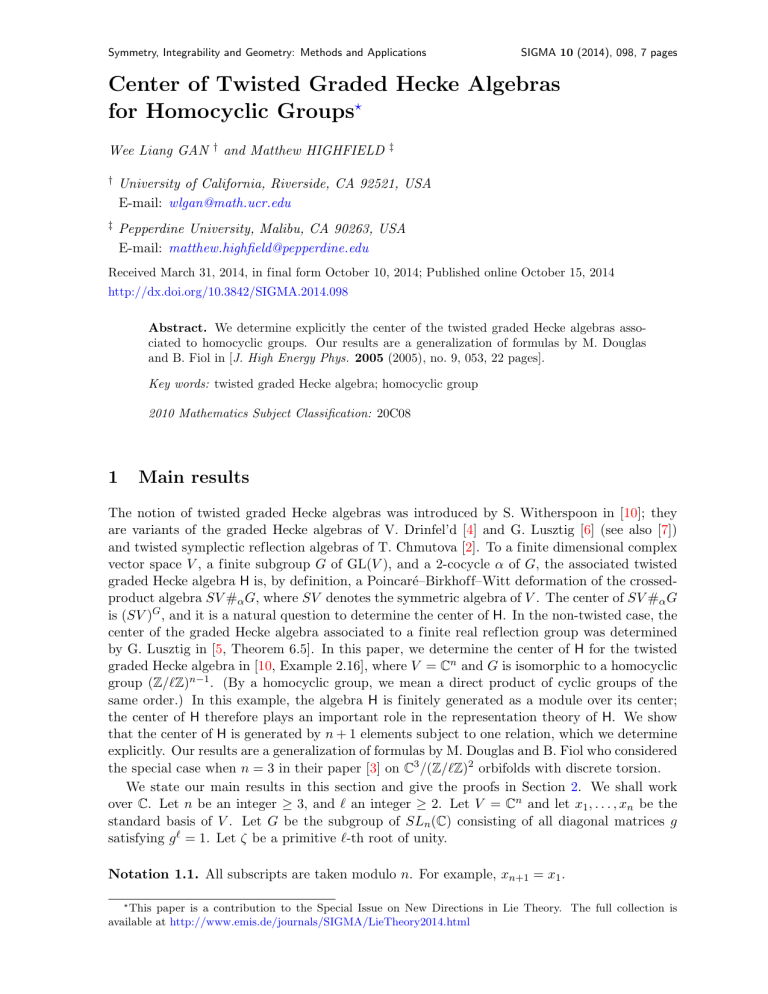
Symmetry, Integrability and Geometry: Methods and Applications
SIGMA 10 (2014), 098, 7 pages
Center of Twisted Graded Hecke Algebras
for Homocyclic Groups?
Wee Liang GAN
†
and Matthew HIGHFIELD
‡
†
University of California, Riverside, CA 92521, USA
E-mail: wlgan@math.ucr.edu
‡
Pepperdine University, Malibu, CA 90263, USA
E-mail: matthew.highfield@pepperdine.edu
Received March 31, 2014, in final form October 10, 2014; Published online October 15, 2014
http://dx.doi.org/10.3842/SIGMA.2014.098
Abstract. We determine explicitly the center of the twisted graded Hecke algebras associated to homocyclic groups. Our results are a generalization of formulas by M. Douglas
and B. Fiol in [J. High Energy Phys. 2005 (2005), no. 9, 053, 22 pages].
Key words: twisted graded Hecke algebra; homocyclic group
2010 Mathematics Subject Classification: 20C08
1
Main results
The notion of twisted graded Hecke algebras was introduced by S. Witherspoon in [10]; they
are variants of the graded Hecke algebras of V. Drinfel’d [4] and G. Lusztig [6] (see also [7])
and twisted symplectic reflection algebras of T. Chmutova [2]. To a finite dimensional complex
vector space V , a finite subgroup G of GL(V ), and a 2-cocycle α of G, the associated twisted
graded Hecke algebra H is, by definition, a Poincaré–Birkhoff–Witt deformation of the crossedproduct algebra SV #α G, where SV denotes the symmetric algebra of V . The center of SV #α G
is (SV )G , and it is a natural question to determine the center of H. In the non-twisted case, the
center of the graded Hecke algebra associated to a finite real reflection group was determined
by G. Lusztig in [5, Theorem 6.5]. In this paper, we determine the center of H for the twisted
graded Hecke algebra in [10, Example 2.16], where V = Cn and G is isomorphic to a homocyclic
group (Z/`Z)n−1 . (By a homocyclic group, we mean a direct product of cyclic groups of the
same order.) In this example, the algebra H is finitely generated as a module over its center;
the center of H therefore plays an important role in the representation theory of H. We show
that the center of H is generated by n + 1 elements subject to one relation, which we determine
explicitly. Our results are a generalization of formulas by M. Douglas and B. Fiol who considered
the special case when n = 3 in their paper [3] on C3 /(Z/`Z)2 orbifolds with discrete torsion.
We state our main results in this section and give the proofs in Section 2. We shall work
over C. Let n be an integer ≥ 3, and ` an integer ≥ 2. Let V = Cn and let x1 , . . . , xn be the
standard basis of V . Let G be the subgroup of SLn (C) consisting of all diagonal matrices g
satisfying g ` = 1. Let ζ be a primitive `-th root of unity.
Notation 1.1. All subscripts are taken modulo n. For example, xn+1 = x1 .
?
This paper is a contribution to the Special Issue on New Directions in Lie Theory. The full collection is
available at http://www.emis.de/journals/SIGMA/LieTheory2014.html
2
W.L. Gan and M. Highfield
For i = 1, . . . , n, let gi be the element of G such that
if j = i,
ζxj ,
−1
gi (xj ) = ζ xj , if j = i + 1,
xj ,
else.
∼
−1
Observe that gn = g1−1 · · · gn−1
. We have an isomorphism (Z/`Z)n−1 −→ G defined by sending
(1, 0, . . . , 0), . . . , (0, . . . , 0, 1) to g1 , . . . , gn−1 , respectively.
Define the 2-cocycle α : G × G → C× of G by
jn−1 in−1 j1
= ζ −i1 j2 −i2 j3 −···−in−2 jn−1 .
, g1 · · · gn−1
α g1i1 · · · gn−1
If E is an algebra, an action of G on E is a homomorphism G → Aut(E). Recall that for any
algebra E and an action of G on E, one has the crossed product algebra E#α G. As a vector
space, E#α G is E ⊗ CG; the product is defined by
(r ⊗ g)(s ⊗ h) = α(g, h)r(g · s) ⊗ gh
for all r, s ∈ E and g, h ∈ G. If g, h ∈ G, then we shall denote their product in E#α G by g ∗ h;
thus,
g ∗ h = α(g, h)gh.
One has, for any i, j ∈ {1, . . . , n} with |i − j| ∈
/ {1, n − 1},
gi+1 ∗ gi = ζgi ∗ gi+1 ,
gi ∗ gj = gj ∗ gi .
Let t = (t1 , . . . , tn ) ∈ Cn , and write T V for the tensor algebra of V . Following [10, Example 2.16],
we make the following definition.
Definition 1.2. Let H be the associative algebra defined as the quotient of T V #α G by the
relations:
xi xi+1 − xi+1 xi = ti gi ,
xi xj − xj xi = 0
for all i, j ∈ {1, . . . , n} with |i − j| ∈
/ {1, n − 1}.
Remark 1.3. By [10, Theorem 2.10] and [10, Example 2.16], the algebra H in Definition 1.2 is
a twisted graded Hecke algebra for G. (However, when n > 3 and ` = 2, this is not the most
general twisted graded Hecke algebra for G; see [10, Example 2.16] and [9, Example 5.1].)
Let C[y1± , . . . , yn± ] be the algebra of Laurent polynomials in the variables y1 , . . . , yn . The
group G acts on C[y1± , . . . , yn± ] by
gi y1p1 · · · ynpn = ζ pi −pi+1 y1p1 · · · ynpn
for all i ∈ {1, . . . , n − 1} and p1 , . . . , pn ∈ Z.
Proposition 1.4. There is an injective homomorphism
Θ : H −→ C[y1± , . . . , yn± ]#α G
such that
Θ(xi ) = yi −
ζti
ζ −1
Θ(gi ) = gi
for all i ∈ {1, . . . , n}.
−1
yi+1
gi ,
(1.1)
(1.2)
Center of Twisted Graded Hecke Algebras for Homocyclic Groups
3
Let
I = {{i1 < · · · < ik } | k ≥ 0; i1 , . . . , ik ∈ {1, . . . , n}},
J = {{i1 < · · · < ik } ∈ I | |ir − is | ∈
/ {1, n − 1} for all r, s}.
Define the elements δ, ε1 , . . . , εn of Zn by
δ = (1, 1, . . . , 1),
ε1 = (1, 1, 0, . . . , 0),
ε2 = (0, 1, 1, 0, . . . ),
...,
εn = (1, 0, . . . , 0, 1).
Notation 1.5. For any variables ω1 , . . . , ωn and p = (p1 , . . . , pn ) ∈ Zn , we denote by ω p the
expression ω1p1 · · · ωnpn .
We shall set
τi =
ti
ζ −1
for i = 1, . . . , n − 1,
τn =
ζtn
.
ζ −1
Define the element w ∈ H by
X
w=
τi1 · · · τik xδ−εi1 −···−εik gi1 ∗ · · · ∗ gik .
{i1 <···<ik }∈J
Example 1.6. If n = 3, then
w = x1 x2 x3 + τ1 x3 g1 + τ2 x1 g2 + τ3 x2 g3 = x1 x2 x3 +
1
(t1 x3 g1 + t2 x1 g2 + ζt3 x2 g3 ) .
ζ −1
In particular, if n = 3 and ` = 2, the formula for w is in [1, Lemma 7.1].
Theorem 1.7. The center of H is generated as an algebra by x`1 , . . . , x`n , and w.
Let Z be the center of H. For r = 0, . . . , b`/2c, set
`−r
r `
,
νr = (−1)
r
`−r
and set
τei = τi`
for i = 1, . . . , n − 1,
τen = (−1)n(`−1) τn` .
We define a polynomial F in the n + 1 variables a1 , . . . , an and b by
b`/2c
X
F =
τei1 · · · τeik aδ−εi1 −···−εik −
X
(−1)nr ζ (n−2)r νr (τ1 · · · τn )r b`−2r .
(1.3)
r=0
{i1 <···<ik }∈J
Corollary 1.8. The assignment
ai 7→ x`i
for
i = 1, . . . , n,
b 7→ w
(1.4)
defines an isomorphism
∼
C[a1 , . . . , an , b]/(F ) −→ Z.
(1.5)
In the undeformed case, when t1 = · · · = tn = 0, the polynomial F is equal to a1 · · · an − b` .
4
W.L. Gan and M. Highfield
2
Proof of main results
Proof of Proposition 1.4. For i = 1, . . . , n − 1, we define Θ(xi ), Θ(xn ), and Θ(gi ) by (1.1)
and (1.2). It follows from a straightforward verification that Θ is a well-defined homomorphism.
It remains to see that Θ is injective. Observe that H is spanned by the monomials xp g for
p = (p1 , . . . , pn ) ∈ Zn and g ∈ G, where p1 , . . . , pn ≥ 0. We call p1 + · · · + pn the total degree of
the monomial xp g. The image of xp g under Θ is the sum of y p g with terms of strictly smaller
total degrees. Therefore, if α ∈ H is nonzero, we can write it as a sum α0 + α1 + · · · , where αk is
a linear combination of monomials xp g with total degree k. If k is the maximal integer with αk
nonzero, then Θ(αk ) is nonzero, and hence Θ(α) is also nonzero.
Remark 2.1. It follows from Proposition 1.4 that the monomials xp11 · · · xpnn g for non-negative
integers p1 , . . . , pn and g ∈ G form a basis for H (called the PBW basis of H). This was first
proved in [10, Example 2.16] using [10, Theorem 2.10].
We have an increasing filtration on H defined by setting deg(xi ) = 1 and deg(g) = 0 for
all i ∈ {1, . . . , n}, g ∈ G. It is immediate from Remark 2.1 that the natural homomorphism
SV #α G → grH is an isomorphism, where grH denotes the associated graded algebra of H.
The proof of (2.3) in the following lemma is the key calculation in this paper.
Lemma 2.2.
(i) One has:
−`
Θ x`i = yi` − τi` yi+1
,
Θ x`n = yn` − (−1)n(`−1) τn` y1−` ,
(2.1)
(2.2)
for all i ∈ {1, . . . , n − 1}.
(ii) One has:
Θ(w) = y1 · · · yn + (−1)n ζ n−2 τ1 · · · τn y1−1 · · · yn−1 .
Proof . (i) To prove (2.1), we need to show that
−`
−1
−1
yi − ζτi yi+1
gi · · · yi − ζτi yi+1
gi = yi` − τi` yi+1
.
|
{z
}
(2.3)
(2.4)
`
−1
−1
Since gi yi = ζyi gi and gi yi+1
= ζyi+1
gi , the product on the left hand side of (2.4) is a linear
k−` `−k
k−` `−k
k
combination of yi yi+1 gi
for k = 0, 1, . . . , `. Moreover, the coefficient of yik yi+1
gi
in this
k
linear combination is the same as the coefficient of u when we expand the product
u − ζ ` τi u − ζ `−1 τi · · · (u − ζτi )
(2.5)
in the polynomial ring C[u]. Since the polynomial in (2.5) is equal to u` − τi` , the identity (2.1)
follows. The proof of (2.2) is similar except that
gn ∗ · · · ∗ gn = (−1)n(`−1) .
{z
}
|
`
(ii) For any h∗ = {h1 < · · · < hj } ∈ I, we let
h0∗ = {hr ∈ h∗ | hs − hr ∈ {1, 1 − n} for some s},
χ(h∗ ) = |{hr ∈ h0∗ | hr 6= n}| − |{hr ∈ h0∗ | hr = n}|,
Center of Twisted Graded Hecke Algebras for Homocyclic Groups
E(h∗ ) = ζ χ(h∗ ) τh1 · · · τhj y
δ−εh1 −···−εhj
5
gh1 ∗ · · · ∗ ghj .
Now suppose i∗ = {i1 < · · · < ik } ∈ J. Let D be the subset of {1, . . . , n} consisting of all d such
that d 6≡ ir , ir + 1 (mod n) for all r. We denote by d1 < · · · < dp the elements of D. Then
Θ τi1 · · · τik xδ−εi1 −···−εik gi1 ∗ · · · ∗ gik
ζtdp −1
ζtd1 −1
= τi1 · · · τik yd1 −
y
gd · · · ydp −
y
gd gi1 ∗ · · · ∗ gik
ζ − 1 d1 +1 1
ζ − 1 dp +1 p
X
Yd1 (S) · · · Ydp (S)gi1 ∗ · · · ∗ gik ,
= τi1 · · · τik
S⊂D
where, for r = 1, . . . , p,
(
ydr ,
if dr ∈
/ S,
Ydr (S) =
−1
−1
−ζ(ζ − 1) tdr ydr +1 gdr , if dr ∈ S.
Setting h∗ = i∗ ∪ S, we obtain1
X
Θ τi1 · · · τik xδ−εi1 −···−εik gi1 ∗ · · · ∗ gik =
(−1)|h∗ |−|i∗ | E(h∗ ).
{h∗ ∈I|i∗ ⊂h∗ −h0∗ }
Hence,
X
Θ(w) =
Θ τi1 · · · τik xδ−εi1 −···−εik gi1 ∗ · · · ∗ gik
{i1 <···<ik }∈J
=
X
X
i∗ ∈J
(−1)|h∗ |−|i∗ | E(h∗ ) =
{h∗ ∈I|i∗ ⊂h∗ −h0∗ }
X
E(h∗ )
h∗ ∈I
X
(−1)|h∗ |−|i∗ | .
i∗ ⊂h∗ −h0∗
If |h∗ | = n, then h0∗ = h∗ . If |h∗ | ∈
/ {0, n}, then h0∗ 6= h∗ . Therefore,
E(h∗ )
X
|h∗ |−|i∗ |
(−1)
i∗ ⊂h∗ −h0∗
y1 · · · yn
= (−1)n ζ n−2 τ1 · · · τn y1−1 · · · yn−1
0
if |h∗ | = 0,
if |h∗ | = n,
else.
Proof of Theorem 1.7. It is easy to see that the center of SV #α G is the algebra of G-invariant
elements (SV )G of SV , and moreover, the algebra (SV )G is generated by x`i (i = 1, . . . , n) and
x1 · · · xn .
Using Lemma 2.2, we see that
Θ x`i
for i = 1, . . . , n,
and
Θ(w)
are in the center of C[y1± , . . . , yn± ]#α G. Since the homomorphism Θ is injective, the elements x`i
(i = 1, . . . , n) and w are in the center of H. Since the principal symbols of x`1 , . . . , x`n and w
in SV #α G are, respectively, x`1 , . . . , x`n and x1 · · · xn , the theorem follows from a standard
argument.
1
Note that if dr ∈ S but dr + 1 ∈ D − S, then the term gdr in Ydr (S) appears on the left of the term ydr +1
of Ydr +1 (S) and one has gdr ydr +1 = ζ −1 ydr +1 gdr . However, if n ∈ S but 1 ∈ D − S, then the term gn in Yn (S)
already appears to the right of the term y1 of Y1 (S). This is the reason why the definition of τn differs from the
corresponding definitions of τ1 , . . . , τn−1 by a factor of ζ.
6
W.L. Gan and M. Highfield
Proof of Corollary 1.8. Let e
a1 = Θ(x`1 ), . . ., e
an = Θ(x`n ), and eb = Θ(w). By Lemma 2.2,
−`
e
ai = yi` − τei yi+1
for i = 1, . . . , n,
eb = y1 · · · yn + (−1)n ζ n−2 τ1 · · · τn y −1 · · · y −1 .
1
n
By a calculation completely similar to the proof of (2.3), one has
X
aδ−εi1 −···−εik = (y1 · · · yn )` + (−1)n` (τ1 · · · τn )` (y1 · · · yn )−` .
τei1 · · · τeik e
(2.6)
{i1 <···<ik }∈J
We claim that we also have
b`/2c
X
(−1)nr ζ (n−2)r νr (τ1 · · · τn )reb`−2r = (y1 · · · yn )` + (−1)n` (τ1 · · · τn )` (y1 · · · yn )−` .
(2.7)
r=0
To see this, recall that the Chebyshev polynomials of the first kind are defined recursively by
T0 (ξ) = 1, T1 (ξ) = ξ, and
Tm (ξ) = 2ξTm−1 (ξ) − Tm−2 (ξ)
for m = 2, 3, . . . .
It is well known (and can be easily proved by induction) that
b`/2c
X
ξ
2T`
=
νr ξ `−2r ,
2
r=0
−1
ξ+ξ
2T`
= ξ ` + ξ −` .
2
(2.8)
(2.9)
By (2.8) and (2.9), one has the identity
b`/2c
ξ ` + ξ −` =
X
νr ξ + ξ −1
`−2r
,
r=0
and hence the identity
b`/2c
2` −`
`
ξ +% ξ
=
X
νr %2r ξ + %2 ξ −1
`−2r
r=0
where ξ and % are formal variables. By setting ξ = y1 · · · yn and choosing % to be a square-root
of (−1)n ζ n−2 τ1 · · · τn , we obtain (2.7).
By Proposition 1.4, Theorem 1.7, and the equations (2.6) and (2.7), the assignment (1.4)
defines a surjective homomorphism
Φ : C[a1 , . . . , an , b] → Z
such that Φ(F ) = 0. Suppose D ∈ C[a1 , . . . , an , b] and Φ(D) = 0. We can write
D=
`−1
X
Dr (a1 , . . . , an )br + R,
r=0
where Dr (a1 , . . . , an ) ∈ C[a1 , . . . , an ] for r = 0, . . . , ` − 1, and R ∈ (F ). Thus,
`−1
X
r=0
Dr x`1 , . . . , x`n wr = 0.
(2.10)
Center of Twisted Graded Hecke Algebras for Homocyclic Groups
7
We claim that Dr (a1 , . . . , an ) = 0 for all r. Suppose not; then let m be the maximal integer
`pn
1
such that Dm (a1 , . . . , an ) 6= 0. Let x`p
be a monomial in Dm (x`1 , . . . , x`n ) with nonzero
1 · · · xn
coefficient. Since 0 ≤ m < `, when we write the left hand side of (2.10) in terms of the PBW
1 +m
basis, the coefficient of x`p
· · · xn`pn +m is nonzero, a contradiction. Hence, the kernel of Φ
1
is (F ). This proves (1.5).
Remark 2.3. When n = 3, the algebra H is Morita equivalent to a deformed Sklyanin algebra Sdef defined by C. Walton in [8, Definition IV.2]. More precisely, if n = 3 and
`−1
1X r
e=
g1 ,
`
r=0
one has HeH = H and eHe ∼
= Sdef where the parameters for Sdef (following the notations in [8,
Definition IV.2]) are a = 1, b = ζ, c = di = 0, and ei = −ζti for i = 1, 2, 3. This follows
from the observation that, for n = 3, setting φi = xi gi+1 , one has φi φi+1 − ζφi+1 φi = ζti for
all i. The algebra Sdef (with above parameters) was first studied by M. Douglas and B. Fiol,
see [3, (3.10)]. Our formulas (1.1)–(1.2) are a generalization of [3, (4.6)], and our equation (1.3)
is a generalization of [3, (4.7)]. The formulas in (2.1)–(2.3) are generalizations of [3, (4.8)].
Acknowledgements
We thank the referees for their many helpful comments.
References
[1] Căldăraru A., Giaquinto A., Witherspoon S., Algebraic deformations arising from orbifolds with discrete
torsion, J. Pure Appl. Algebra 187 (2004), 51–70, math.KT/0210027.
[2] Chmutova T., Twisted symplectic reflection algebras, math.RT/0505653.
[3] Douglas M.R., Fiol B., D-branes and discrete torsion. II, J. High Energy Phys. 2005 (2005), no. 9, 053,
22 pages, hep-th/9903031.
[4] Drinfel’d V.G., Degenerate affine Hecke algebras and Yangians, Funct. Anal. Appl. 20 (1986), 58–60.
[5] Lusztig G., Cuspidal local systems and graded Hecke algebras. I, Inst. Hautes Études Sci. Publ. Math.
(1988), 145–202.
[6] Lusztig G., Affine Hecke algebras and their graded version, J. Amer. Math. Soc. 2 (1989), 599–635.
[7] Ram A., Shepler A.V., Classification of graded Hecke algebras for complex reflection groups, Comment.
Math. Helv. 78 (2003), 308–334, math.GR/0209135.
[8] Walton C.M., On degenerations and deformations of Sklyanin algebras, Ph.D. Thesis, University of Michigan,
2011.
[9] Witherspoon S., Skew derivations and deformations of a family of group crossed products, Comm. Algebra
34 (2006), 4187–4206, math.RA/0506154.
[10] Witherspoon S., Twisted graded Hecke algebras, J. Algebra 317 (2007), 30–42, math.RT/0506152.
